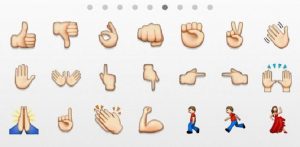By Sarah-Claire Jordan
 As we talked about in an earlier post, there has been some form of established iconography used to make communication easier since at least the 1920s, when “isotype” was created. It was never meant to be a replacement for translation and interpretation, but rather a tool that could be used in instances where verbal language failed. One very probable incarnation of isotype could be the emoji, which were originally developed and used in Japan.
As we talked about in an earlier post, there has been some form of established iconography used to make communication easier since at least the 1920s, when “isotype” was created. It was never meant to be a replacement for translation and interpretation, but rather a tool that could be used in instances where verbal language failed. One very probable incarnation of isotype could be the emoji, which were originally developed and used in Japan.
Emojis include everything from smiley faces to symbols for different countries and are used extensively in social media and messenger applications. They were originally designed to be used only with mobile devices, specifically text messaging and similar apps, but have since bled over into Facebook, Twitter, Instagram, and any other social media powerhouse you can think of. Not only do they use emojis, though, but each social media network seems to have its own kind of emojis, meaning that not all symbols can be used on every social network and making emojis and translation a difficult idea.
The basic concept behind emojis is human emotions, which are more or less universal. A smile means the same thing in every language, as the saying goes, and so does a frown, a scared face, an angry face, etc. Since it is something with Japanese origins, however, there are many emojis, regardless of which app or social network is using them, that are culturally specific to Japanese. These include a face with a face mask on, a businessman bowing, and an assortment of popular Japanese foods. Using these particular emojis and translation could lead to some interesting outcomes.
Besides these, emojis are meant to be universal and understood by anyone, to the point where they could even be used instead of text. This has been tested by a translation company to see if the language someone speaks influences how they interpret phrases depicted using only emojis. It turns out, even when culturally-specific emoji are avoided, speakers of different languages will still interpret the same emoji phrase differently sometimes.
A perfect example of this is the use of a face with a face mask followed by a flexed arm to signify illness but then recovery. French translators took a look at these two emojis and came up with “bicep surgery”, which does make sense. The mask could be a surgical mask, and the body part used to mean “recovery” is an arm with a prominent bicep. This just shows how inaccurate and confusing things could get if emojis were used instead of language or at least more universal symbols. Many people seem to think that, since they see a certain meaning in an emoji, everyone must see that same meaning.
With the rise of social media networks and mobile technology, along with our penchant as a species to try to find shortcuts for everything, it is highly probable that translators, especially those who translate for social media, will have to figure out the best way to deal with accurately conveying an emoji’s meaning. Context will surely play a huge role, but even then, some sort of emoji glossary for each language might be a good idea in order to help translators navigate yet another layer of dialects.




